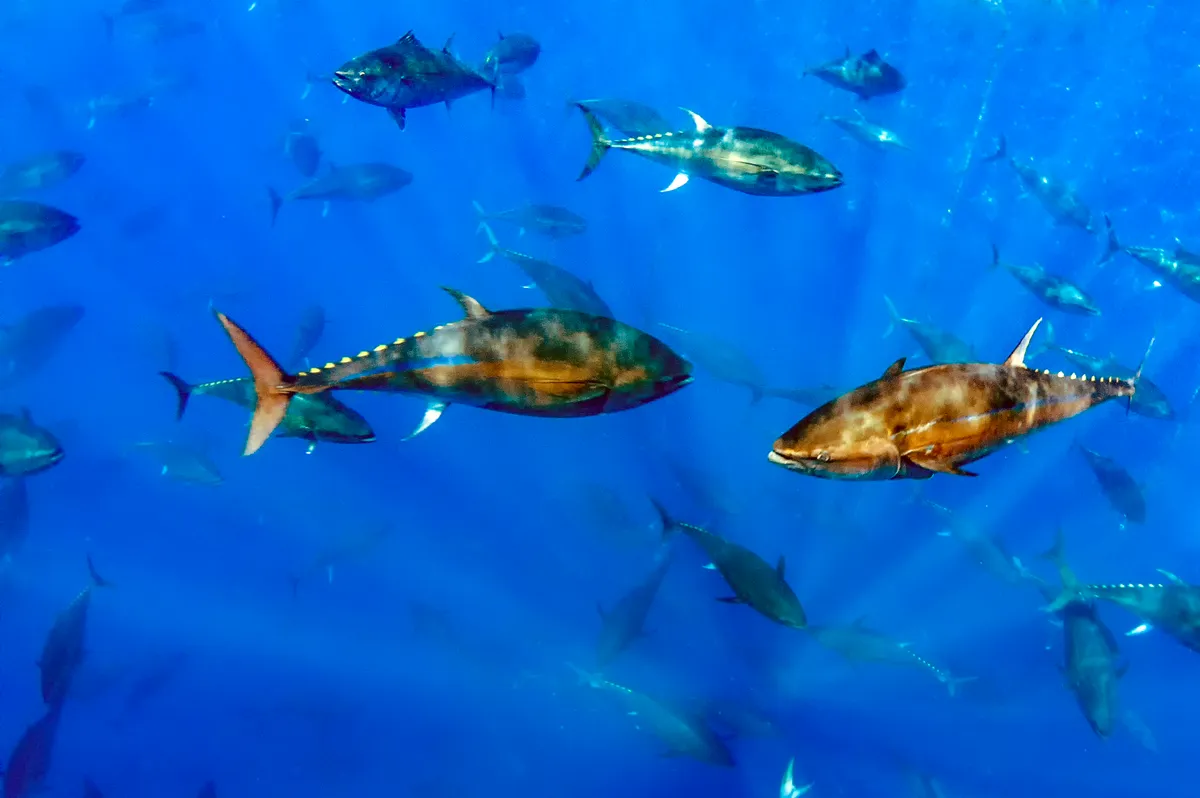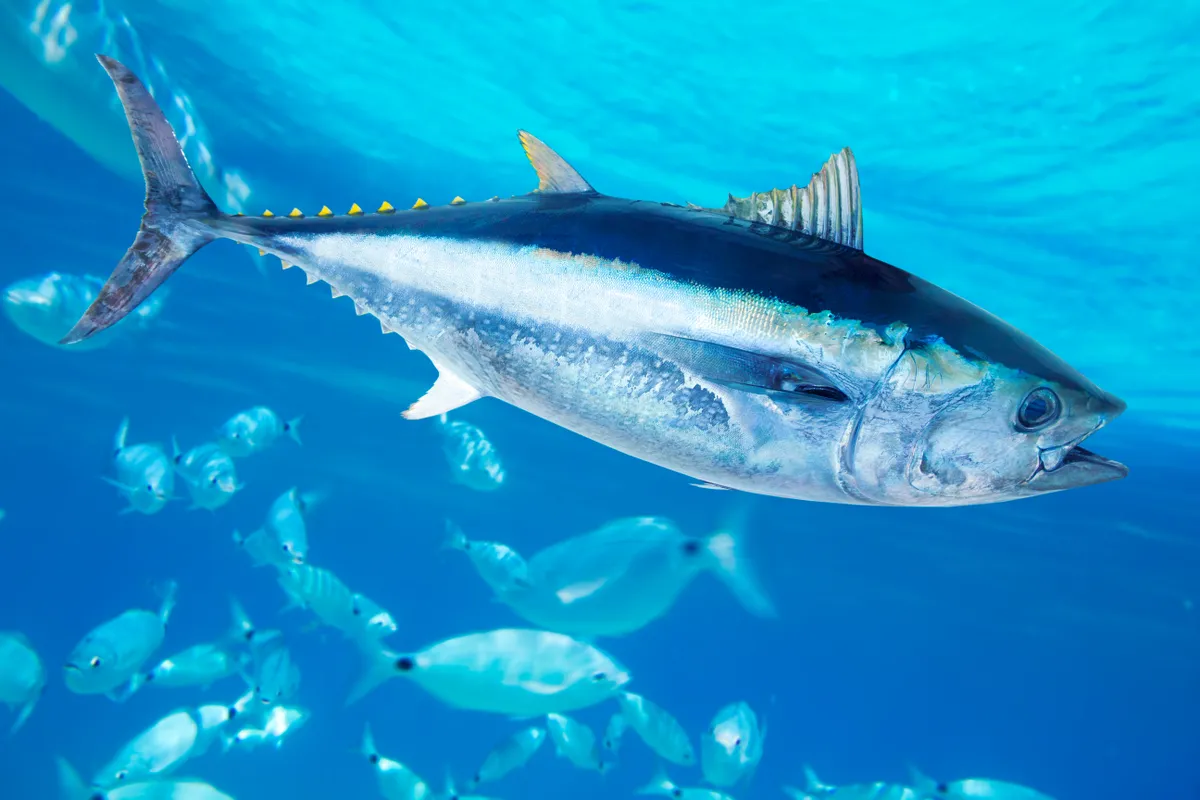Atlantic bluefin tuna used to be a common sight here in UK waters, but these large fish disappeared in the 1960s, most likely wiped out by commercial fisheries in the north-east Atlantic.
In the early 2010s, however, bluefin tuna began staging a comeback in the English Channel and off the west coast of Ireland. From incredible speeds to serious sardine consumption, we answer your bluefin tuna questions.
How many tuna species are there?
There are 15 species of tuna in the world, of which the Atlantic bluefin is the largest.
How big are bluefin tuna?
Atlantic bluefin tuna are the biggest of three bluefin species (the other two are from the Pacific Ocean), at up to 4.5 metres long and 650kg, the weight of two grizzly bears. There are two sub-populations; one living and spawning in the East Atlantic and Mediterranean, the second in the Gulf of Mexico.

How do bluefin tuna breathe?
To breathe, bluefin tuna open their mouths and let water pour across their gills. Known as ram ventilation, it means tuna must keep swimming forwards to breathe. Their feathery gill filaments are fused together, making them stiffer so they don’t bend too much when swimming at speed.
How do bluefin tuna see?
Atlantic bluefin tuna rely on supremely sharp vision to catch prey. Scientists discovered that the Pacific bluefin sees green colours especially well thanks to five copies of a gene for the version of the visual pigment, opsin, that detects green wavelengths. This helps them spot prey in the blue ocean.
Why are bluefin tuna used for sushi?
Bluefin tuna are prized in the sushi trade for their meaty red muscles, which are adapted for the high-duration, low-intensity work associated with endurance swimming. Their muscles are packed with mitochondria, the structures inside cells that generate energy, and they contain high concentrations of the oxygen-binding protein, myoglobin.

How do bluefin tuna swim?
When swimming steadily at high speeds, bluefin tuna retract their pectoral fins into slots in the sides of their body. This improves their streamlining and reduces drag. At slower speeds, their pectoral fins stick out to help them to save energy by gliding.
How fast can bluefin tuna swim?
Bluefins are piscine powerhouses, swimming at speeds of up to 72kph (45mph). Like many large, predatory fish — such as swordfish and marlin — bluefin tuna have crescent-shaped caudal (tail) fins. The shape creates plenty of thrust with minimal drag, assisting them as they cruise on long migrations and also when they put on bursts of speed.

How intelligent are they?
Bluefins are believed to be one of the more intelligent fish species, capable of problem-solving and coordinated hunting.
What do they eat?
When young, bluefins will eat squid and crustaceans, while adults tend to favour fish such as mackerel, herring and sardines.
How much do they eat?
A tuna will typically consume 5% of its bodyweight each day, meaning a 250kg (550lb) tuna will eat 12.5kg (27lb) of fish per day.
Do they swim in shoals?
Yes, bluefins will typically remain in shoals with members of a similar size, though they will intermingle with other tuna species where their ranges cross.
What's special about their fins?
Bluefin tuna have a row of flexible, yellow finlets along their backs. These cut down the energy they use while swimming, probably by reducing how much they rotate their head from left to right, known as yaw torque.
Is bluefin tuna a sustainable food source?
Potentially, yes. The current revival is hugely positive but impacts of fishing must be carefully monitored and quotas strictly maintained.
Atlantic bluefin tuna vs Pacific bluefin tuna
Pacific bluefin tuna, close relatives of the Atlantic species, use hydraulics to alter the angle of their dorsal and anal fin. Muscles pump fluid into their fins from their lymphatic system. As the pressure increases, the fins stand more upright and stiff, assisting them as they make sharp, fast turns.
Bluefin tuna body temperature
Heat-exchanging blood vessels help bluefins retain heat from their muscles and keep their eyes and brain warmer than the sea. The heart receives cold blood straight from the gills and has biochemical adaptations to keep beating even at very low temperatures when they dive down to 915m.
How long do bluefin tuna live?
Bluefin tuna ear bones, called otoliths, contain annual growth rings; similar to tree rings, they can be used to work out a fish’s age. Studies have found bluefin can live for at least 32 years, maybe as long as 50.
Discover more about the UK's marine life
Main image: close up of a bluefin tuna. Credit: Getty





